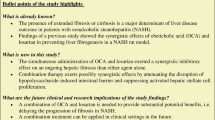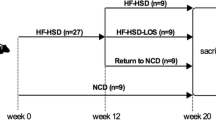Abstract
Background and Aims
Ursodeoxycholic acid (UDCA) is considered to be effective in the treatment of nonalcoholic steatohepatitis (NASH), particularly in combination with other pharmacological agents. UDCA reportedly counteracts the effects of endotoxemia. Previously, we demonstrated attenuated hepatic fibrogenesis and suppression of activated hepatic stellate cells (Ac-HSC) with an angiotensin-II (AT-II) type 1 receptor blocker (ARB). Here we evaluated the simultaneous effect of both agents on hepatic fibrogenesis in a rat model of NASH.
Methods
Fischer 344 rats were fed a choline-deficient l-amino-acid-defined (CDAA) diet for 8 weeks. The therapeutic effect of UDCA and ARB was evaluated along with hepatic fibrogenesis, lipopolysaccharide (LPS)-Toll-like receptor 4 (TLR4) regulatory cascade, and intestinal barrier function. The direct inhibitory effect of both UDCA and ARB on Ac-HSC was assessed in vitro.
Results
Both UDCA and ARB had a potent inhibitory effect on hepatic fibrogenesis with suppression of the HSC activation and hepatic expression of transforming growth factor (TGF)-β1 and TLR4. UDCA decreased intestinal permeability by ameliorating zonula occuludens-1 (ZO-1) disruption induced by the CDAA diet. ARB was found to directly suppress regulation of Ac-HSC.
Conclusions
UDCA and ARB have a synergistic repressive effect on hepatic fibrogenesis by counteracting endotoxemia induced by intestinal barrier dysfunction and suppressing the activation of Ac-HSC. Because both agents are currently used in clinical practice, combined UDCA and ARB may represent a promising novel therapeutic approach for NASH.







Similar content being viewed by others
References
Lindor KD, Kowdley KV, Heathcote EJ, et al. Ursodeoxycholic acid for treatment of nonalcoholic steatohepatitis: results of a randomized trial. Hepatology. 2004;39:770–8.
Dufour JF, Oneta CM, Gonvers JJ, et al. Randomized placebo-controlled trial of ursodeoxycholic acid with vitamin E in nonalcoholic steatohepatitis. Clin Gastroenterol Hepatol. 2006;4:1537–43.
Leuschner UF, Lindenthal B, Herrmann G, et al. High-dose ursodeoxycholic acid therapy for nonalcoholic steatohepatitis: a double-blind, randomized, placebo-controlled trial. Hepatology. 2010;52:472–9.
Ratziu V, de Ledinghen V, Oberti F, et al. A randomized controlled trial of high-dose ursodeoxycholic acid for nonalcoholic steatohepatitis. J Hepatol. 2011;54:1011–9.
Douhara A, Moriya K, Yoshiji H, et al. Reduction of endotoxin attenuates liver fibrosis through suppression of hepatic stellate cell activation and remission of intestinal permeability in a rat non-alcoholic steatohepatitis model. Mol Med Rep. 2015;11:1693–700.
Machado MV, Cortez-Pinto H. Gut microbiota and nonalcoholic fatty liver disease. Ann Hepatol. 2012;11:440–9.
Bertok L. Effect of bile acids on endotoxin in vitro and in vivo (physico-chemical defense). Bile deficiency and endotoxin translocation. Ann N Y Acad Sci. 1998;851:408–10.
Yoshiji H, Yoshii J, Ikenaka Y, et al. Inhibition of renin-angiotensin system attenuates liver enzyme-altered preneoplastic lesions and fibrosis development in rats. J Hepatol. 2002;37:22–30.
Yoshiji H, Kuriyama S, Noguchi R, et al. Angiotensin-I converting enzyme inhibitors as potential anti-angiogenic agents for cancer therapy. Curr Cancer Drug Targets. 2004;4:555–67.
Yoshiji H, Kuriyama S, Fukui H. Angiotensin-I-converting enzyme inhibitors may be an alternative anti-angiogenic strategy in the treatment of liver fibrosis and hepatocellular carcinoma. Possible role of vascular endothelial growth factor. Tumour Biol. 2002;23:348–56.
Yoshiji H, Kuriyama S, Yoshii J, et al. Angiotensin-II type 1 receptor interaction is a major regulator for liver fibrosis development in rats. Hepatology. 2001;34:745–50.
Yoshiji H, Noguchi R, Ikenaka Y, et al. Losartan, an angiotensin-II type 1 receptor blocker, attenuates the liver fibrosis development of non-alcoholic steatohepatitis in the rat. BMC Res Notes. 2009;2:70.
Yoshiji H, Noguchi R, Ikenaka Y, et al. Cocktail therapy with a combination of interferon, ribavirin and angiotensin-II type 1 receptor blocker attenuates murine liver fibrosis development. Int J Mol Med. 2011;28:81–8.
Shirai Y, Yoshiji H, Noguchi R, et al. Cross talk between Toll-like receptor-4 signaling and angiotensin-II in liver fibrosis development in the rat model of non-alcoholic steatohepatitis. J Gastroenterol Hepatol. 2013;28:723–30.
Ishizaki K, Iwaki T, Kinoshita S, et al. Ursodeoxycholic acid protects concanavalin A-induced mouse liver injury through inhibition of intrahepatic tumor necrosis factor-alpha and macrophage inflammatory protein-2 production. Eur J Pharmacol. 2008;578:57–64.
Setchell KD, Rodrigues CM, Clerici C, et al. Bile acid concentrations in human and rat liver tissue and in hepatocyte nuclei. Gastroenterology. 1997;112:226–35.
Michel MC, Foster C, Brunner HR, et al. A systematic comparison of the properties of clinically used angiotensin II type 1 receptor antagonists. Pharmacol Rev. 2013;65:809–48.
Remuzzi A, Perico N, Amuchastegui CS, et al. Short- and long-term effect of angiotensin II receptor blockade in rats with experimental diabetes. J Am Soc Nephrol. 1993;4:40–9.
Noguchi R, Yoshiji H, Ikenaka Y, et al. Dual blockade of angiotensin-II and aldosterone suppresses the progression of a non-diabetic rat model of steatohepatitis. Hepatol Res. 2013;43:765–74.
Kleiner DE, Brunt EM, Van Natta M, et al. Design and validation of a histological scoring system for nonalcoholic fatty liver disease. Hepatology. 2005;41:1313–21.
Aihara Y, Yoshiji H, Noguchi R, et al. Direct renin inhibitor, aliskiren, attenuates the progression of non-alcoholic steatohepatitis in the rat model. Hepatol Res. 2013;43:1241–50.
Seki E, De Minicis S, Osterreicher CH, et al. TLR4 enhances TGF-beta signaling and hepatic fibrosis. Nat Med. 2007;13:1324–32.
Ulluwishewa D, Anderson RC, McNabb WC, et al. Regulation of tight junction permeability by intestinal bacteria and dietary components. J Nutr. 2011;141:769–76.
Trauner M, Graziadei IW. Review article: mechanisms of action and therapeutic applications of ursodeoxycholic acid in chronic liver diseases. Aliment Pharmacol Ther. 1999;13:979–96.
Buko VU, Kuzmitskaya-Nikolaeva IA, Naruta EE, et al. Ursodeoxycholic acid dose-dependently improves liver injury in rats fed a methionine- and choline-deficient diet. Hepatol Res. 2011;41:647–59.
Bjornsson E. The clinical aspects of non-alcoholic fatty liver disease. Minerva Gastroenterol Dietol. 2008;54:7–18.
Buko VU, Lukivskaya OY, Zavodnik LV, et al. Antioxidative effect of ursodeoxycholic acid in the liver of rats with oxidative stress caused by gamma-irradiation. Ukr Biokhim Zh. 2002;74:88–92.
Li X, Wang C, Nie J, et al. Toll-like receptor 4 increases intestinal permeability through up-regulation of membrane PKC activity in alcoholic steatohepatitis. Alcohol. 2013;47:459–65.
Guo S, Al-Sadi R, Said HM, et al. Lipopolysaccharide causes an increase in intestinal tight junction permeability in vitro and in vivo by inducing enterocyte membrane expression and localization of TLR-4 and CD14. Am J Pathol. 2013;182:375–87.
Bruewer M, Luegering A, Kucharzik T, et al. Proinflammatory cytokines disrupt epithelial barrier function by apoptosis-independent mechanisms. J Immunol. 2003;171:6164–72.
Schwarzenberg SJ, Bundy M. Ursodeoxycholic acid modifies gut-derived endotoxemia in neonatal rats. Pediatr Res. 1994;35:214–7.
Sombetzki M, Fuchs CD, Fickert P, et al. 24-nor-ursodeoxycholic acid ameliorates inflammatory response and liver fibrosis in a murine model of hepatic schistosomiasis. J Hepatol. 2015;62:871–8.
Friedman SL. Mechanisms of hepatic fibrogenesis. Gastroenterology. 2008;134:1655–69.
Liang TJ, Yuan JH, Tan YR, et al. Effect of ursodeoxycholic acid on TGF beta1/Smad signaling pathway in rat hepatic stellate cells. Chin Med J (Engl). 2009;122:1209–13.
Roth S, Michel K, Gressner AM. (Latent) transforming growth factor beta in liver parenchymal cells, its injury-dependent release, and paracrine effects on rat hepatic stellate cells. Hepatology. 1998;27:1003–12.
Armendariz-Borunda J, Seyer JM, Kang AH, et al. Regulation of TGF beta gene expression in rat liver intoxicated with carbon tetrachloride. FASEB J. 1990;4:215–21.
Author information
Authors and Affiliations
Corresponding author
Ethics declarations
Conflict of interest
The authors declare that they have no conflict of interest.
Electronic supplementary material
Below is the link to the electronic supplementary material.
535_2015_1104_MOESM1_ESM.pptx
Fig. S1 Inhibitory effect of UDCA and ARB on hepatic expression of connective tissue growth factor and alpha-2-HS-glycoprotein during hepatic fibrosis. (A) Hepatic expression of CTGF was elevated in the CDAA fed rats (G2) compared to CSAA fed rats (G1).The CDAA‑induced increase was significantly inhibited by treatment with UDCA (G3) and ARB (G4) compared with CDAA control group. Similar to the effect on hepatic fibrosis, the combination treatment with both agents exerted a more potent inhibitory effect on CTGF expression than that of either agent alone, and these inhibitory effects were almost parallel to the fibrosis area reduction. (B) Hepatic mRNA expression of alpha-2-HS-glycoprotein (Fetuin A/AHSG), surrogate marker for hepatic steatosis significantly increased in G2 and the CDAA-induced increase in AHSG significantly reduced in UDCA-treated rats (G3) and UDCA- and ARB-treated rats (G5). However, no significant reduction was found in ARB-treated rats (G4). Values are mean±SD (bars; n = 10). Asterisks indicate statistically significant difference between indicated experimental groups (* p < 0.05, ** p < 0.01). G1, CSAA-treated control group; G2, CDAA with vehicle-treated group; G3, CDAA with UDCA-treated group; G4, CDAA with ARB-treated group; G5, CDAA with UDCA- and ARB-treated group. (PPTX 64 kb)
535_2015_1104_MOESM2_ESM.pptx
Fig. S2 Inhibitory effect of UDCA and ARB on the TLR4 protein expression in the liver and the intestine. (A) The hepatic TLR4 protein expression increased in the CDAA diet group (G2). This increase was significantly suppressed by treatment with UDCA and ARB.The combination treatment of both agents (G4) exerted a more potent inhibitory effect than that of either agent alone. These inhibitory effects were almost parallel to the fibrosis area reduction. (B) However, no significant differences were detected in protein expression of intestinal TLR4 between G1 and G2. Values are represented as mean ± SD (bars; n = 10). Asterisks indicate statistically significant difference between indicated experimental groups (* p < 0.05, ** p < 0.01) (PPTX 386 kb)
535_2015_1104_MOESM3_ESM.pptx
Fig. S3 The inhibitory effect of UDCA and ARB on the expression of hepatic inflammatory cytokines, tumor necrosis factor-alpha (A), Interferon-gamma (B) and Interleukin-6 (C) using ELISA. All three hepatic proinflammatory cytokines were augmented in CDAA fed group. These diet-induced alterations in these pro-inflammatory cytokines were suppressed in UDCA treated group and combination treatment group (G5), whereas treatment with ARB did not significantly alter the expression of the three proinflammatory cytokines. Values are represented as mean ± SD (bars; n = 10). Asterisks indicate statistically significant difference between indicated experimental groups (** p < 0.01). (PPTX 76 kb)
Rights and permissions
About this article
Cite this article
Namisaki, T., Noguchi, R., Moriya, K. et al. Beneficial effects of combined ursodeoxycholic acid and angiotensin-II type 1 receptor blocker on hepatic fibrogenesis in a rat model of nonalcoholic steatohepatitis. J Gastroenterol 51, 162–172 (2016). https://doi.org/10.1007/s00535-015-1104-x
Received:
Accepted:
Published:
Issue Date:
DOI: https://doi.org/10.1007/s00535-015-1104-x




